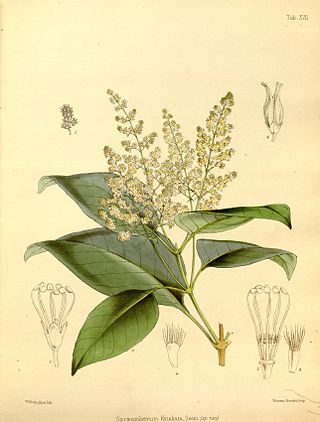
Weinmannia is a genus of trees and shrubs in the family Cunoniaceae. It contains 90 species, which range from Mexico through Central and South America including the Caribbean, and to the Mascarene Islands in the western Indian Ocean. It is absent from mainland Africa and Australia, but some fossils have been attributed to Weinmannia in Australia.

Geissois is a genus of trees and shrubs in the plant family Cunoniaceae. It includes about 19 species mostly found in New Caledonia, but also in Fiji, Vanuatu, and the Solomon Islands. Leaves are opposite, palmate with 3-9 leaflets, with entire margin and intrapetiolar stipules. The inflorescences are simple racemes and bottle-brush like. The flowers have four red sepals, lacking petals, with many long red stamens. The fruit is a capsule, the seeds flat and winged. The genus includes several nickel hyperaccumulator and one aluminum hyperaccumulator, Geissois polyphylla.
Pancheria humboldtiana is a species of shrub in the family Cunoniaceae. It is endemic to New Caledonia where it is rare and found only on a few mountains.

Pancheria is a genus of shrubs and trees in the family Cunoniaceae. It is to endemic to New Caledonia and contains 27 species. Leaves or whorled, simple or pinnate. The flowers are arranged in capitula, fruits are follicular. The species are dioecious. The genus is well diversified on ultramafic rocks and some species are nickel hyperaccumulators. It is related to Cunonia and Pterophylla. It was named after Jean Armand Isidore Pancher.
Pancheria robusta is a species of shrub in the family Cunoniaceae. It is endemic to New Caledonia, where it is rare and found only on a few mountains.

Spiraeanthemum is a genus of trees and shrubs in the family Cunoniaceae. it includes about 19 species from Australia, New Guinea, Solomon Islands, New Caledonia, Vanuatu, Fiji and Samoa. Leaves are simple, opposite or whorled, with toothed or entire margins. Inflorescences are paniculate, flowers unisexual or hermaphrodite, and the fruits are follicular with free carpels. It belongs to the tribe Spiraeanthemeae, and now includes the species formerly placed in Acsmithia.
Pterophylla affinis, formerly known as Weinmannia affinis, is a species of plant in the family Cunoniaceae. It is native to Fiji and the Samoan Islands.
Pterophylla exigua, formerly known as Weinmannia exigua, is a species of plant in the family Cunoniaceae. It is endemic to Fiji. This scarce shrub or small tree is known from a single population of 30 to 40 individual plants in Cakaudrove Province on Vanua Levu. It grows in forest or thicket at low elevations. Its known habitat is in at high risk of fires.
Pterophylla ouaiemensis, formerly known as Weinmannia ouaiemensis, is a species of plant in the family Cunoniaceae. It is endemic to New Caledonia.
Pterophylla raiateensis, formerly known as Weinmannia raiateensis, is a species of plant in the family Cunoniaceae. It is endemic to the island of Raiatea, in the Society Islands of French Polynesia.
Weinmannia rapensis is a species of plant in the family Cunoniaceae. It is a tree endemic to Rapa Iti in the Tubuai Islands of French Polynesia.
Pterophylla richii, formerly Weinmannia richii, is a species of plant in the family Cunoniaceae. It is a shrub or tree endemic to Fiji.
Pterophylla vitiensis, formerly known as Weinmannia vitiensis, is a species of plant in the family Cunoniaceae. It is endemic to Fiji.

Cunonia is a genus of shrubs and trees in the family Cunoniaceae. The genus has a disjunct distribution, with 24 species endemic to New Caledonia in the Pacific, and one species in Southern Africa. Leaves are opposite, simple or pinnate with a margin entire to serrate. Interpetiolar stipules are often conspicuous and generally enclose buds to form a spoon-like shape. Flowers are bisexual, white, red, or green, arranged in racemes. The fruit is a capsule opening first around the base then vertically, seeds are winged.

Codia is a genus of trees and shrubs in the family Cunoniaceae. The genus is endemic to New Caledonia in the Pacific and contains 15 species. The leaves are opposite or whorled, simple, and the margin usually entire. The flowers are arranged in capitula. the ovary is inferior. The fruit is indehiscent and is covered with woolly hairs.

Karrabina is a genus of trees in the family Cunoniaceae. It is endemic to eastern Australia and includes two species: Karrabina benthamiana and Karrabina biagiana, previously placed in the genus Geissois.
Hooglandia ignambiensis is a species of trees in the family Cunoniaceae. It is endemic to New Caledonia and the only species of the genus Hooglandia. It is named after Dutch botanist Ruurd Dirk Hoogland.
Peripterygia marginata is a species of shrubs in the family Celastraceae. It is endemic to New Caledonia and the only species of the genus Peripterygia. Its closest relatives are Crossopetalum and Siphonodon.
Flore de la Nouvelle-Calédonie is an ongoing multi-volume flora describing the vascular plants of New Caledonia in the South-West Pacific. published by the National Museum of Natural History in Paris since 1967. Each species treatment typically includes taxonomic information, morphological description, a line drawing and a distribution map. Originally published as Flore de la Nouvelle-Calédonie et Dépendances, since 2014 it has been renamed shortly Flore de la Nouvelle-Calédonie and is co-published with Institut de Recherche pour le Développement in a fully colored format. Flore de la Nouvelle-Calédonie currently consists of 27 volumes, covering little over 50% of a total of approximately 3,400 species native to the New Caledonian archipelago. Major botanical families awaiting treatment include Rubiaceae, Cyperaceae, Rutaceae, and Poaceae.

Pterophylla is a genus of trees of the family Cunoniaceae, with species found growing naturally in Madagascar, Malesia, Papuasia, and the Pacific Islands, formerly included in Weinmannia.








